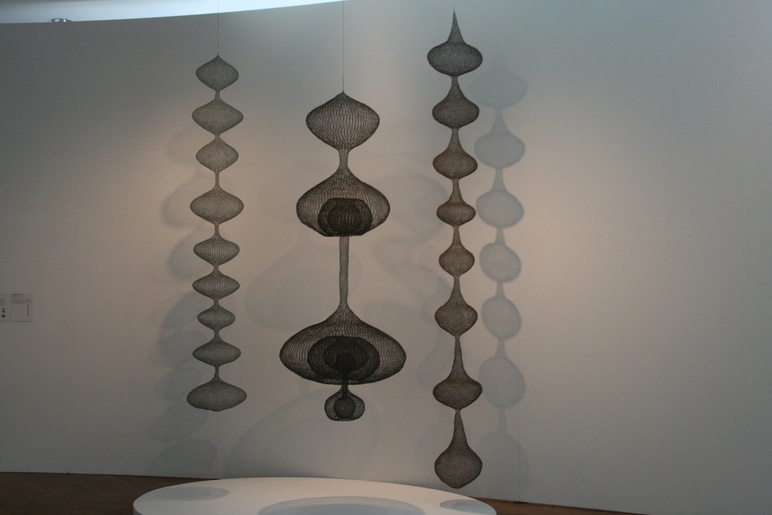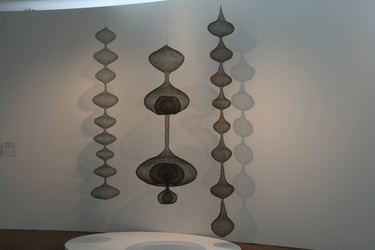The Sculpture of Ruth Asawa: Contours in the Air - Audio Tour

|
||
| Licensing | ||
Ruth Asawa, one of the most important female artists of the 20th century, was born in 1926 in Norwalk, California. She is the fourth of seven children. Her parents were truck farmers, so Ruth and her six siblings worked long hours on the farm.
Ruth’s first experience using a paint brush—and possibly her first experience with art—was at Japanese school in Norwalk, where she was asked to try calligraphy.
After the bombing of Pearl Harbor, Ruth and her family were taken to the assembly center in Santa Anita, California, and then to Rowher Relocation Center in Arkansas. While in Santa Anita, Ruth had the opportunity to take art classes from a few incarcerated Disney Studios artists. There, she painted from real life instead of copying pictures from books.
Ruth also took art and drawing classes at Rowher. Once she graduated from high school, Ruth decided to attend Milwaukee State Teachers College; she wanted to become an art teacher.
Once she realized that this goal may never be achieved, due to anti-Japanese sentiment, Ruth packed her bags and left for Black Mountain College in North Carolina. There, she learned many new techniques and principles that she would later emit through her own work.
Ruth married Albert Lanier on July 3, 1949 in San Francisco, where they lived and raised their six children. Ruth continued to paint and to sculpt, creating innovative and breathtaking pieces. Ruth is most known for her popular looped and tied wire sculptures.
Ruth's pieces were displayed at the Japanese American National Museum from March 10, 2007 through May 27, 2007 in The Sculpture of Ruth Asawa: Contours in the Air. Organized by the Fine Arts Museum of San Francisco, the exhibition constituted the first complete retrospective of Ruth Asawa's enduring and richly varied career.
This collection features audio clips originally recorded for a cell phone tour by Guide by Cell to accompany the exhibition. The audio clips were recorded by Karin Higa, Senior Curator of Art at the Japanese American National Museum, and Aiko Cuneo, Ruth Asawa's daughter in March 2007.
Slides in this album |
|

|
Looped Wire SculptureThese looped wire pieces were displayed at the Japanese American National Museum during the exhibition The Sculpture of Ruth Asawa: Contours in the Air from March 10 to May 27, 2007. They are only a small fraction of the many, many beautiful sculptures Ruth Asawa created throughout her …
Ruth Asawa Exhibition - Japanese American National Museum |
|
|
Welcome to "The Sculpture of Ruth Asawa: Contours in the Air"Narrator: Sabrina Motley, Japanese American National Museum Transcription Welcome to The Sculpture of Ruth Asawa: Contours in the Air, originally organized by the Fine Arts Museum of San Francisco, now on display at the Japanese American National Museum. This exhibition represents the first complete retrospective to showcase Ruth Asawa’s career, …
The Sculpture of Ruth Asawa: Contours in the Air - Audio Tour Clip #1: Welcome message |
|
|
Ruth Asawa - At a GlanceNarrator: Karin Higa, Senior Curator of Art, Japanese American National Museum Transcription So, I wanted to tell you a little bit about Ruth Asawa. She was born to Japanese immigrants on a farm in Norwalk here in Southern California. And, she is one of the country’s pioneering modernist sculptors, somebody …
The Sculpture of Ruth Asawa: Contours in the Air - Audio Tour Clip #2: Ruth Asawa history |
|
|
Drawing vs. Wire ArtNarrators: Transcription The immediacy of drawing was central to Ruth Asawa’s practice as an artist, for her wire was like a line, and wire sculptures functioned as three-dimensional drawings in space. As such, her calloused …
The Sculpture of Ruth Asawa: Contours in the Air - Audio Tour Clip #3: Looped wire sculptures |
|
|
Tied Wire SculpturesNarrator: Aiko Cuneo, Ruth Asawa's daughter Transcription The tied wire sculptures are called tied wire because they’re tied in bunches with a smaller piece of wire. The bunches are divided, and then these newly created smaller bunches are tied, and then divided again. So, it’s a series of tying and …
The Sculpture of Ruth Asawa: Contours in the Air - Audio Tour Clip #4: Tied wire sculptures |
|
|
Types of WireNarrator: Karin Higa, Senior Curator of Art, Japanese American National Museum Transcription Ruth Asawa used different types of wire in her sculpture, in part because each metal had a slightly different characteristic that she could exploit in creating the sculpture. They also had different color, and you can see in …
The Sculpture of Ruth Asawa: Contours in the Air - Audio Tour Clip #5: Using different types of wire |
|
|
Achieving TransparenciesNarrator: Aiko Cuneo, Ruth Asawa's daughter Transcription Ruth used a variety of wires, including iron, brass, copper, bronze, stainless steel, galvanized steel, aluminum, monel and even gold-filled wire. Each wire had its different physical and visual properties. She used iron for her earlier sculptures, then tried copper and brass. She …
The Sculpture of Ruth Asawa: Contours in the Air - Audio Tour Clip #6: Types of wire |
|
|
Imogen and RuthNarrator: Aiko Cuneo, Ruth Asawa's daughter Transcription Imogen Cunningham and Ruth Asawa had a friendship that lasted many years. Ruth drew Imogen, Imogen photographed Ruth over the years, and photographed Ruth’s family. In trade for sculpture and photography, they were two women who decided they were going to have children …
The Sculpture of Ruth Asawa: Contours in the Air - Audio Tour Clip #7: Friendship with Imogen Cunningham |
|
|
Black Mountain CollegeNarrator: Daniell Cornell, Curator and Director of Contemporary Arts Projects, Fine Arts Museum of San Francisco Transcription At the end of her third year at Milwaukee State Teacher’s college in 1946, Ruth found that she was unable to complete her degree, because anti-Japanese sentiment was still so strong from the …
The Sculpture of Ruth Asawa: Contours in the Air - Audio Tour Clip #8: Black Mountain College |
|
|
LithographyNarrator: Daniell Cornell, Curator and Director of Contemporary Arts Projects, Fine Arts Museum of San Francisco Transcription In 1965, through the support and recommendation of Joseph Albers, Ruth was able to attend the Tamarind Lithography workshop through a fellowship that she attained as the artist in residency there. The workshop …
The Sculpture of Ruth Asawa: Contours in the Air - Audio Tour Clip #9: Tamarind Lithography workshop |
|
|
PlatingNarrator: Aiko Cuneo, Ruth Asawa's daughter Transcription Ruth would take her sculptures to be cleaned, or have them dipped in these tanks to change the color of the wire, to plate them… it was called a plating company. There were also these electro-plating tanks there, and she saw one of …
The Sculpture of Ruth Asawa: Contours in the Air - Audio Tour Clip #10: Electro-Plated Sculptures |
|
|
Art and the Complexity of Ethnic IdentityNarrator: Karin Higa, Senior Curator of Art, Japanese American National Museum Transcription In many ways, Ruth Asawa is a typical Japanese American Nisei, the child of immigrants who came to the United States to carve out a better life for themselves and their children. But her life and art are …
The Sculpture of Ruth Asawa: Contours in the Air - Audio Tour Clip #11: Importance to Japanese American community |
 eishida
eishida
 UCLA Nikkei Student Union Culture Night 2008
UCLA Nikkei Student Union Culture Night 2008 The Sculpture of Ruth Asawa: Contours in the Air - Audio Tour
The Sculpture of Ruth Asawa: Contours in the Air - Audio Tour Wakatay Restaurant-Peruvian Nikkei Cuisine
Wakatay Restaurant-Peruvian Nikkei Cuisine 2007 Gardena Buddhist Church Obon
2007 Gardena Buddhist Church Obon Frank Kikuchi
Frank Kikuchi Hisako Hibi
Hisako Hibi San Jose Taiko and CAVA - 1st and Central Summer Concerts 2007
San Jose Taiko and CAVA - 1st and Central Summer Concerts 2007 2007 Higashi Honganji Buddhist Temple Obon
2007 Higashi Honganji Buddhist Temple Obon Landscaping America: Beyond the Japanese Garden - Timeline
Landscaping America: Beyond the Japanese Garden - Timeline Jack Iwata Collection
Jack Iwata Collection
 Journal feed
Journal feed
